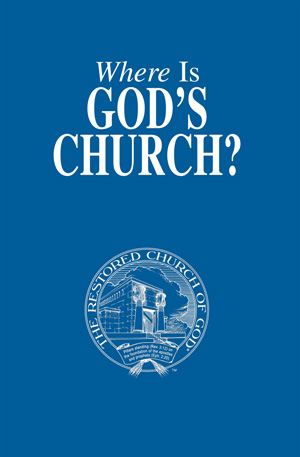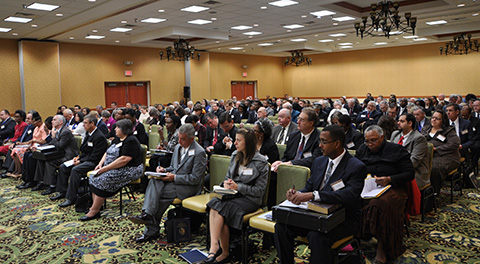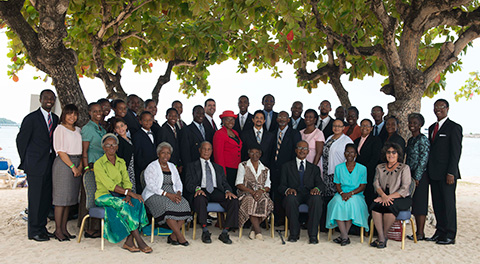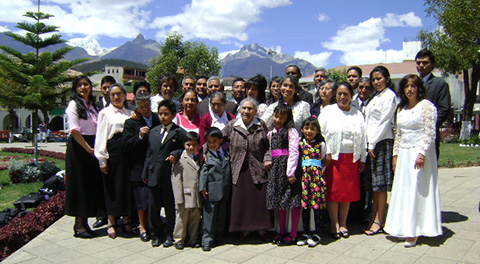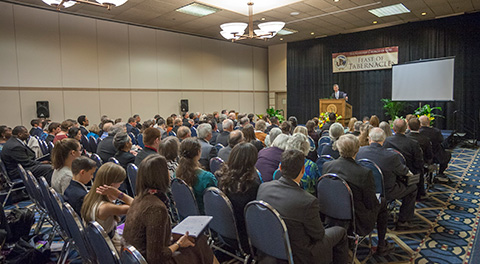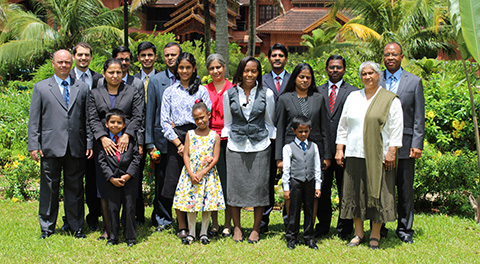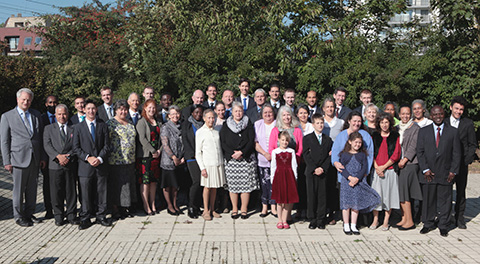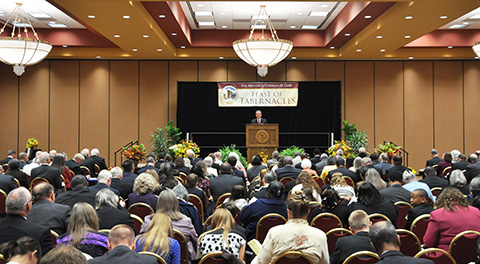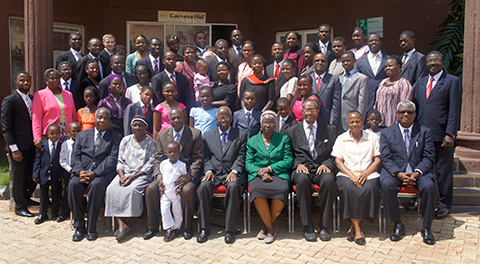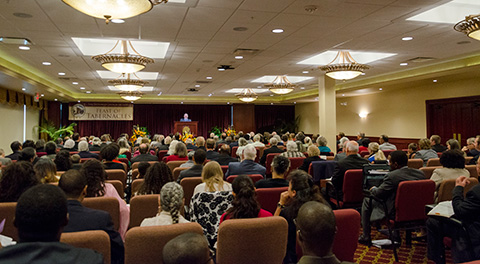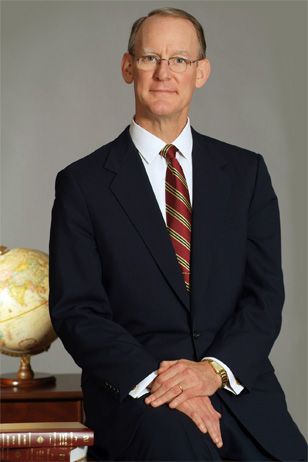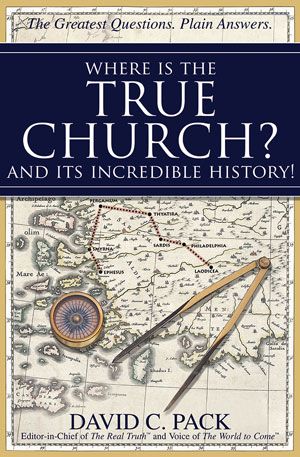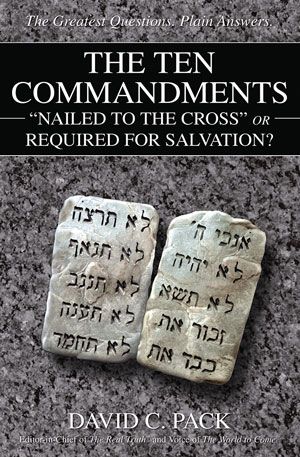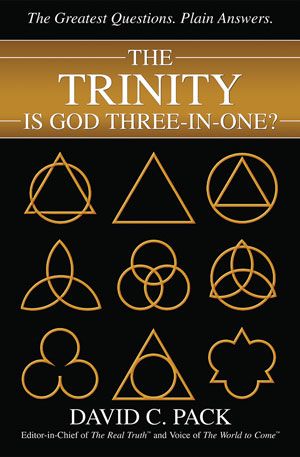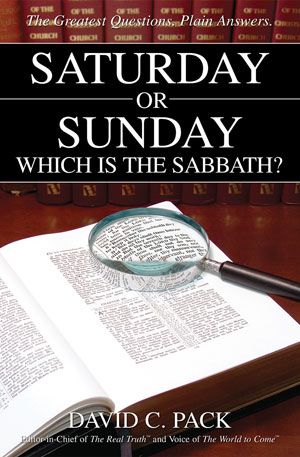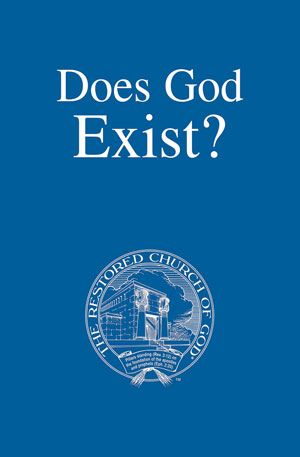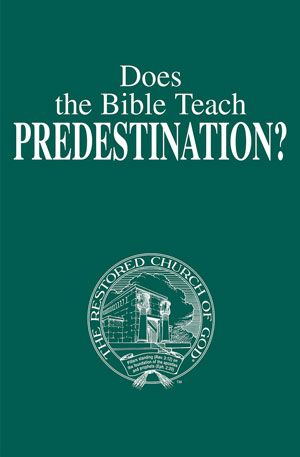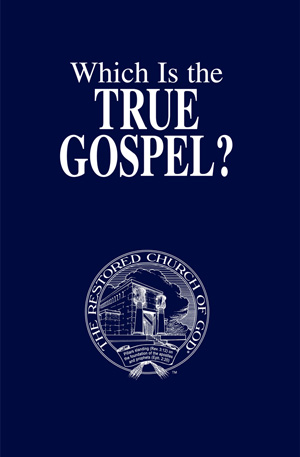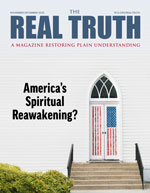Jesus Christ declared, “I will build My Church” (Matt. 16:18). No matter how men interpret it, this passage speaks of a single church! Christ continued, “and the gates of hell [the grave] shall not prevail against it.” He promised that His Church could never be destroyed.
Over 2,000 different professing Christian church organizations have been “built” by men in the United States. Another is started every three days. Estimates place the number of professing Christians at above 2 billion. While church attendance seems to be increasing, it is not increasing as fast as the confusion surrounding the question of which is the right church.
While it has been said, “They can’t all be wrong,” it is more correct to say, “They cannot all be right.” If Christ built His Church as He said, then it can be found somewhere on Earth today—and it is the only right Church. But we must ask: How do we find it—what do we look for—how do we identify it—how do we know it if we see it?
My mother required me to read many books when growing up. I spent many summers reading her assigned “book a week.” I enjoyed most of them and am very thankful she did this. On occasion, perhaps two or three times, I picked up the Bible and attempted to read it. But I never got far, because it made no sense to me. I simply could not understand the Bible.
Despite this lack of understanding, upon turning sixteen, I was “confirmed” into the church that I had been born into. I recall having to appear briefly before a panel of “deacons” to answer some questions, which I no longer remember. I do recall making some kind of general affirmation about this denomination, but I also remember that I was not concerned in the least with whether or not I was in the right church, or if I was fulfilling the Bible definition of a Christian.
Neither of these questions remotely interested me. I did vaguely believe that God existed, but He was not real to me. I had certainly never attempted to build a personal relationship with Him or to find His true Church. I did not pray or study His Word for guidance or doctrinal instruction. These concerns did not enter my mind until a year and a half later, in 1966, when I heard a powerful voice on the radio that introduced me to Christ’s statement in Matthew 16:18. I began to question where I could find this true Church. I immediately realized that it had to exist because, through just basic study, I came to understand Christ’s promise that it would remain and could not be destroyed.
Traditions of Men
Christ said, “But in vain they do worship Me, teaching for doctrines the commandments of men” (Matt. 15:9). In Mark’s parallel account of this statement, He continued, “Full well you reject the commandment of God, that you may keep your own tradition” (7:9).
The world’s Christianity is filled with traditions. One of the largest is the traditional view of the New Testament Church. Most ministers, theologians and religionists typically define the church in this way: “All those who sincerely believe in Jesus Christ as their Savior comprise the true Church.” This is often followed with the familiar statement, “There are many routes to heaven” or “There are many spokes on the wheel of salvation.” Though the Bible does not teach that heaven is the reward of the saved, the clear implication of these is that people can believe what they want, or be a part of any group that they choose, and still be Christians—still receive whatever is salvation. While people may sincerely believe these traditional ideas, they are sincerely wrong!
My research led me to absolute proof of where the Church was that Christ promised to build. I learned that this Church could be carefully traced through almost 2,000 years of New Testament history. I was shocked. I could not believe the Bible was so clear on a subject that confuses so many.
Your Bible declares, “God is not the author of confusion, but of peace, as in all churches of the saints [the context shows this refers to all congregations of the true Church, not all organizations of men]” (I Cor. 14:33).
God’s Church (composed of many congregations of saints) was to reflect peace—not confusion. You need not be confused about the identity of the true Church. God commands, “Prove all things; hold fast that which is good” (I Thes. 5:21). While this certainly refers to scriptural matters (not the car you drive or house you buy), it does say that “ALL things,” not “some things,” should be proven! Surely God would not exclude something of such magnitude—such vital importance—as the matter of where His true Church is found. And He would never emphatically tell people to prove things that cannot be proven!
The more I studied the other doctrines of the Bible, the more I learned that the churches of this world were wrong—on virtually everything! One plain scripture after another contradicted each traditional “Christian” idea I had been taught. I was amazed—actually stunned—at how easy it was to find direct, clear, undeniable proof that even the most popular traditions of the big denominations were not based on the Bible—at all!
Each time I studied a Bible doctrine—salvation, baptism, who and what God is, the gospel, death and hell, law and sin, grace, being born again, the Christian Sabbath, the true origin of supposed “Christian” holidays, where the modern-day tribes of ancient Israel are found today, the sequence of prophetic events preceding Christ’s Return and so much more—I gained undeniable proof of what the Bible really taught! I was excited and fascinated. I found that the churches of this world were almost invariably confused on all these and many other plain points of Bible teaching. I came to realize that there had to be a church that correctly believed and practiced all the doctrines of the Bible.
I learned that this Church existed, and that the proof identifying it and setting it apart from all the churches of recognized, mainstream Christianity was no different than the proof of any other biblical doctrine.
A Persecuted Little Flock
When speaking to His disciples about the importance of seeking the kingdom of God, Jesus said, “Fear not, little flock; for it is your Father’s good pleasure to give you the kingdom” (Luke 12:32). By no stretch can churches comprised of millions, let alone over 2 billion, be considered a “little flock.”
Jesus understood that His Church—His little flock—would be persecuted and despised by the world. Just before His crucifixion, He warned, “Remember the word that I said unto you, The servant is not greater than his lord. If they have persecuted Me, they will also persecute you” (John 15:20). In the previous verse in the context, Jesus had reminded His disciples that “I have chosen you out of the world, therefore the world hates you.” Christ was persecuted, to the point of horrible crucifixion after a night of brutal torture. Therefore, the true Church could also expect to be persecuted—and hated! Those in it are not “of the world.” The world senses this and hates them for it (John 17:14; Rom. 8:7). Christ used the apostle Paul to record, “Yes, and all that will live godly in Christ Jesus shall suffer persecution” (II Tim. 3:12). The word “all” means what it says!
Consider what we have just discussed. How many churches can you name that are small, persecuted, not of this world—and even hated because of it? Think about those you are familiar with. Do any fit this description? Surely not many!
The Importance of the Name of the Church
The world’s churches have many different names, which are derived in various ways. These include the particular doctrines they teach, the names of the men who founded them, the humanly-devised type of church government that they espouse, their location, or their intended scope and size, such as universal or catholic—in order to be thought of as all-encompassing.
On the night of His betrayal, Christ prayed for His Church. Here is what He said: “Holy Father, keep through your own name those whom You have given Me, that they may be one, as We are. While I was with them in the world, I kept them in your name … I have given them Your word; and the world has hated them, because they are not of the world, even as I am not of the world. I pray not that You should take them out of the world, but that You should keep them from the evil. They are not of the world, even as I am not of the world. Sanctify them through Your truth: Your word is truth” (John 17:11-12, 14-17).
There are twelve separate places where the New Testament records that the true Church has been kept in the name of the Father—God. The first five refer to the entire Church, or Body of Christ, as a whole. The next four speak of a specific local congregation, while using the same term “Church of God.” This may refer to the Church of God at Judea or Corinth, etc. The final three references speak collectively of all the individual local congregations combined. All these references use the term “Churches of God”:
(1) Acts 20:28: This verse is instruction to the elders to “feed the church of god.”
(2) I Corinthians 10:32: “Give none offense, neither to the Jews, nor to the Gentiles, nor to the church of god.”
(3) I Corinthians 11:22: “…or despise you the church of god, and shame them that have not?”
(4) I Corinthians 15:9: Paul wrote the same thing to two congregations: “For…I persecuted the church of god.”
(5) Galatians 1:13: “I persecuted the church of god.”
(6) I Corinthians 1:2: “the church of god which is at Corinth.”
(7) II Corinthians 1:1: “the church of god which is at Corinth.”
(8) I Timothy 3:5: Paul references any elder in a local congregation: “For if a man know not how to rule his own house, how shall he take care of the church of god?”
(9) I Timothy 3:15: “…behave yourself in the house of God, which is the church of the living god.” This verse adds a descriptive word to God by using the term “living.”
(10) I Corinthians 11:16: “…We have no such custom, neither the churches of god.”
(11) I Thessalonians 2:14: “For you…became followers of the churches of god which in Judea are in Christ Jesus.”
(12) II Thessalonians 1:4: “So that we ourselves glory in you in the churches of god.”
In the modern age, for corporate reasons, the Church may use an additional descriptive name to distinguish itself from other “Churches of God”—those merely appropriating God’s name, but not obeying His commandments, believing His true doctrines or doing His Work. Herbert W. Armstrong, the twentieth-century leader of the Church, chose the name Worldwide Church of God and before that, Radio Church of God. We have chosen the name The Restored Church of God.
Just as various mainstream denominations may have a few correct doctrines mixed with much error, some appropriate to themselves the name of God’s Church. This booklet will later explain why some few churches may even have a significant amount of truth, but choose to accept a variety of false doctrines. Only one church on the face of the earth has the correct name and teaches all the additional many true doctrines that the Bible teaches! Recall that Christ prayed, “Sanctify them through Your truth: Your word is truth.” The Church that Christ works through, directs and guides is sanctified—set apart—by its belief of the plain truth of God’s Word!
In addition to carrying the name “Church of God,” we have seen that the true Church has come out of the world, is small and persecuted, even to the point of being hated by it. This Church is then also set apart by its beliefs and practices—which are in complete agreement with the truth of the Bible!
Unified Through God’s Word
Men have their own differing definitions of what the Church actually is, but only the Bible definition—God’s definition—matters. Read it for yourself. Paul wrote to Timothy, “…that you may know how you ought to behave yourself in the house of God, which is the Church of the living God, the pillar and ground of the truth” (I Tim. 3:15). In the end, no other definition, devised by men, is acceptable. This definition of the Church Christ built will guide us throughout the remainder of this booklet. God’s Church has and teaches “the truth.”
We have discussed how this world’s churches are in confusion, divided by endless disagreement over doctrine and practice. Amos 3:3 asks, “Can two walk together, except they be agreed?” The answer is NO!
This world’s churches do not practice the principle of “Man shall not live by bread alone, but by every word of God” (Luke 4:4), exactly as written. Instead, since they follow the many differing traditions of men, endless disagreements separate, divide and create more and more churches of men. They generally do not “walk together,” because they do not “agree”—either with each other or God!
God’s Church is different. Many New Testament verses show that the Church Christ built is unified—with all its members and congregations walking together in complete agreement with each other, and with God and Christ.
An important point, demonstrating the unity of the true Church, emerges from Christ’s same prayer in John 17, on the night of His betrayal. He prayed, “And for their sakes I sanctify Myself, that they also might be sanctified [set apart] through the truth…That they all may be one; as You, Father, are in Me, and I in You, that they also may be one in Us: that the world may believe that You have sent Me. And the glory which You gave Me I have given them; that they may be one, even as We are one: I in them, and You in Me, that they may be made perfect in one; and that the world may know that You have sent Me, and have loved them, as You have loved Me” (vs. 19, 21-23).
These are powerful statements! Christ intended that His Church be unified—“one”—no less than were He and His Father! There is no room for disagreement in a Church that is this unified. These verses describe a perfect oneness through the truth—the same kind of oneness that the Father and Christ enjoy. It is this kind of unity that allows true Christians to be “in” them—be in Christ and the Father (vs. 21).
Even in the Old Testament, David was inspired to record, “Behold, how good and how pleasant it is for brethren to dwell together in unity ” (Psa. 133:1).
We now must examine several New Testament passages to see if, in fact, this kind of wonderful unity was apparent after the New Testament Church actually formed. Did God’s true servants teach and administer this kind of agreement? And how is that unity achieved?
First, notice this early picture of God’s Church. On the day of Pentecost, gathered in “one accord” (Acts 2:1), when the New Testament Church came into existence, 3,000 converts were baptized. They formed the very beginning of Christ’s building of His Church. The initial description given was “…and they continued steadfastly in the apostles’ doctrine and fellowship” (vs. 42), “…all that believed were together” (vs. 44) and “…they, continuing daily with one accord…did eat their meat [food] with gladness and singleness of heart” (vs. 46). From these verses, we clearly see that the Church Christ built was unified—in agreement—over doctrine, and together. Notice verse 47: “And the Lord added to the Church daily such as should be saved.” In the Church Christ guides and directs, He is the One who adds to it, building it!
Only One Body
The New Testament speaks of the Church of God as the same thing as the Body of Christ. This introduces remarkable understanding.
In his letter to the Corinthians, Paul recorded that the Church had many separate members (brethren), yet was like various parts of the human body, in that these members were connected. Carefully study chapter 12. Verses 12 to 14 state, “For as the body is one, and has many members, and all the members of that one body, being many, are one body: so also is Christ. For by one Spirit are we all baptized into one body …For the body is not one member, but many.”
When one is converted—has repented, been baptized and received the Holy Spirit—this verse reveals that he has actually been placed into the Body of Christ as well as into the Church of God.
Many have been confused by what this means. In other words, exactly what is the Church or Body of Christ into which one has been baptized?
The context of chapter 12 uses the analogy of hands, feet, eyes, ears and the mouth to show how different parts of a human body are connected within the same person. Paul continues, “But now has God set the members every one of them in the body, as it has pleased Him. And if they were all one member, where were the body? But now are they many members, yet but one body” (vs. 18-20).
Let’s understand what this means. The “Christian” world teaches that the Body of Christ—Jesus’ Church—consists of many denominations, fellowships or “communities of believers,” said to all be connected by the “Holy Spirit” working in believers wherever they are affiliated. (Many, many sources attest to this thinking.) But this is totally contrary to what the Bible teaches about the Body of Christ. This substitute—counterfeit!—idea asserts, in effect, that Christ and His Body are divided among many groups or organizations. We will see that this is not true.
I Corinthians 12 cannot be “spiritualized away” by human reasoning. It does not describe an amorphous, disconnected, “spiritual” body of disagreeing people and organizations throughout professing Christianity. Any foot, eye or ear that is taken from a human body dies! No severed body part can live for very long without blood supply and the connective tissue necessary to secure it to the body. God created the human body, so He obviously understands the analogy that He inspired.
For further proof of the meaning of body, consider two additional scriptures, written to two separate congregations under Paul’s leadership.
Notice his statement to the Colossian congregation: “And He [Christ] is the head of the body, the Church” (1:18). Now see his instruction to the Ephesian congregation. Speaking of what God placed under Christ’s control, Paul wrote, “…and gave Him [Christ] to be the Head over all things to the Church, which is His body” (1:22-23). The Bible definition of the Body of Christ is the Church! They are the same.
In chapter 4 of Ephesians, Paul admonished the brethren to be “Endeavoring to keep the unity of the Spirit in the bond of peace. There is one body [Church], and one Spirit, even as you are called in one hope of your calling; one Lord, one faith, one baptism, one God and Father” (3-6). Again, there must be no confusing the all-encompassing unity and agreement that this verse requires of God’s people. Recall how Christ prayed for this kind of oneness and unity.
A few verses later, Paul described the importance of a faithful ministry, actively working with and teaching Christ’s Church. Carefully read and understand the following lengthy, important passage: “And He gave some, apostles; and some, prophets; and some, evangelists; and some, pastors and teachers; for the perfecting of the saints, for the work of the ministry, for the edifying of the body of Christ: till we all come in the unity of the faith, and of the knowledge of the Son of God, unto a perfect man, unto the measure of the stature of the fulness of Christ: that we henceforth be no more children, tossed to and fro, and carried about with every wind of doctrine, by the sleight of men, and cunning craftiness, whereby they lie in wait to deceive; but speaking the truth in love, may grow up into Him in all things, which is the Head, even Christ: from whom the whole body fitly joined together and compacted by that which every joint supplies, according to the effectual working in the measure of every part, makes increase of the body unto the edifying of itself in love” (vs. 11-16).
The Church is a type of Christ’s own Body and, as its Head, He governs, directs and builds it, adding to it daily. These verses describe it as being unified in both doctrinal truth and love. (See the inset later in the booklet to understand how these two overarching points work together.) In phrase after phrase, this passage demonstrates that the entire Church (“whole body” and “every part”) must be walking together in complete doctrinal agreement under Christ’s authority. And He works through His true ministers to keep the Church from drifting into “every wind of doctrine.”
Why Many Groups?—Some History!
The next two sections form related insets, the first to help the reader understand why the supposed Christian world has so many differing churches.
The universal church, centered at Rome, and teaching the false doctrine of the trinity, has always taught that the Body of Christ was solely composed of those within that church. Even though the Roman church taught doctrines that were almost entirely the tradition of men, their understanding that Christ led one undivided, organized spiritual Body, identified in a single church, was largely correct. Their error was connecting this key doctrine to themselves instead of to the true Church of God, led by the true Jesus Christ (II Cor. 11:4).
Let’s understand this by tying together several critical elements that clarify the thinking of the Protestant Reformers. When they rebelled against Rome, they were obviously no longer part of that church, and thus had departed from what they previously believed to have been the sole Body of Christ. They knew that Paul taught, “For by one Spirit are we all baptized into one body” and “For the body is not one member, but many” (I Cor. 12:13-14).
The entire world of Christendom is able to read this passage, and others, about the Body of Christ. All of these had to be reconciled with the fact that they had now left the Roman church and its authority. But here was their problem: They had to come up with a teaching compatible with converts and believers supposedly being truly baptized, but now into a divided, competing and multiplying picture of denominations that is the Protestant world. They had to reconcile the idea of “one Body of Christ” with the reality of hundreds of Protestant denominations—and other groups—with more appearing all the time. They were forced to conclude Christ’s Body is composed of many organizations, denominations, fellowships and “communities of believers.” But this is utterly false!
Built Upon Which Rock?—Peter the First Pope?
When the Protestant Reformers rejected Rome’s authority, they were simultaneously rejecting the rule of popes over the church. Also as an inset, let’s briefly return to Matthew 16:18—where Christ said, “I will build My Church”—this time examining His statement to Peter.
Let’s first read: “And I say also unto you, That you are Peter, and upon this rock I will build My church; and the gates of hell shall not prevail against it.”
This verse is the single bedrock scripture to Catholic theology regarding the supposed authority of popes, who are said to derive their authority directly from Christ’s supposed empowerment of Peter, and thus his successors in an unbroken line ever since. Over a billion Catholics today, and generations before them, have been taught that the passage designates Peter as the first pope. The verse simply does not say this, and the reader needs to understand what it does say—what Christ meant by His statement.
Breaking down the important Greek words within this verse makes it easier to understand:
Peter comes from the Greek word petros, meaning a piece of rock, but either bigger or smaller than a stone. (Note that the Greek word for stone is lithos, essentially meaning a medium-sized rock.) The Greek word for Rock is petra, which means a mass of rock, usually very large.
Let’s carefully examine and understand. Verse 13 mentions that Christ was speaking at Caesarea Philippi. It is significant that He chose this site to speak of His Church! Here is why.
This city is in the far north of today’s Israel, about 25 miles north of Capernaum and the Sea of Galilee. Located at the foot of Mt. Hermon, it is where one of the three main branches of the Jordan River originates. The area is very beautiful.
I have stood on the spot from which Christ delivered these words. This is what I saw—and what anyone would see: Immediately above where the river springs from the base of a cliff is a massive rock outcropping that dominates the topography. Its presence towers over the landscape. None who were present when Christ spoke these words could possibly have believed He was talking about building His Church on Peter, whom He compared to a little rock. The enormous physical size of the rock looming directly over Christ’s head reinforced His message that He was building the Church on a giant Rock—HIMSELF! This is, no doubt, why He picked this setting to utter His words in Matthew 16:18 to His disciples, and to Peter.
In effect, Christ was saying that Peter was a small rock. On the other hand, Jesus Christ is the large rock, or foundation stone of the Church that He built. Christ is actually distinguishing between the two. Proof that the mass of rock is Christ can be found in I Corinthians 10:4, Ephesians 2:20, Matthew 7:24 and 16:13-16.
Understand that Christ is the great Rock that the Church is built upon. This verse is absolutely not saying that Peter is either that massive rock or that the Church is built on him. I Corinthians 3:11 shows there can be only one foundation (Christ), not two. Obviously, this applies to Peter’s role. Ephesians 4:11-12 explains that apostles (Peter, Paul, John, etc.) were in offices that Christ established to serve His Church. Collectively, with the prophets, they form part of the Church’s foundation—alongside Christ (Eph. 2:20).
Think of Christ as having complimented Peter. Then there is this: If He had established Peter as the first (and infallible) pope, how could Peter almost immediately have fallen into what Christ labeled a satanic attitude in the very next verses, 21 to 23? Take a moment to read them. Would such an attitude be possible for one who was spiritually infallible? Also, there is this question: How could Peter have later denied Christ three times?
Here are ten proofs that Peter was probably never even in Rome—and therefore could not have been the first pope:
(1) Paul was the apostle to the Gentiles (Rom. 15:16; Gal. 2:7) not Peter. Rome was a Gentile city.
(2) The Emperor Claudius had banished all Jews from Rome in AD 50 (also see #9 below).
(3) Peter went to Babylon—in Mesopotamia (I Pet. 5:13).
(4) Paul would never have written what he did in Romans 1 (the book was written in AD 55), verses 11 and 15—clear insults to Peter if he had been faithfully serving there for thirteen previous years (from AD 42), particularly if it had been as pope. Actually, a “Peter,” Simon Magus (see the account in Acts 8), was there. It was this Simon (not Simon Peter) who was the Pater (or Peter), which means “a father.” (Paternity and patriarch come from this word.) Simon Magus was already by this time the leading figure in the early apostate church at Rome.
(5) Romans 15:20: The apostle Paul declared that he would not preach (or write) upon any other man’s foundation. Yet, Paul wrote the letter to the Romans. Thus, Peter could not have laid the foundation of the Roman congregation.
(6) Romans 16 contains thirty different salutations, yet Peter, supposedly the resident “pope” there, was not greeted by Paul. Think of what a grievous slight this would have been had he been present. Paul’s epistle did not even acknowledge Peter.
(7) Galatians 1:18-19 and 2:7 demonstrate that Peter was based at Jerusalem, from where he periodically traveled to places like Bithynia, Northern Galatia and Babylon, and other places where Israelites (also see #9) had migrated, from AD 38 to AD 49—the dates of these events described in Galatians.
(8) Notice Luke 22:24. Related to these points, if Peter was already designated to be the future pope, why did the disciples argue among themselves about which of them was the greatest?
(9) Galatians 2:7 reveals that Peter took the gospel to “the circumcision”—the Jews, and the other tribes of Israel, referenced in #7. (See Matthew 10:5-6.)
(10) II Timothy 4:10-11 mentions that Paul wrote from Rome and records that “only Luke was with him”—obviously this eliminates Peter.
Although not the subject of this booklet, Peter was, in fact, the leading apostle in the early New Testament Church, but he simply was not the first pope and certainly did not even live in Rome.
Paul Stressed Unity
A great deal can be learned by examining Paul’s instructions to various other congregations he was overseeing. He continually stressed unity and oneness within the true Church of God.
The corinthian congregation had many problems—including terrible division and disunity. Early in his letter to this congregation, Paul strongly admonished them to stop entertaining other doctrines and to quit playing favorites with ministers. Notice: “Now I beseech you, brethren…that you all speak the same thing, and that there be no divisions among you; but that you be perfectly joined together in the same mind and in the same judgment…Now this I say, that every one of you says, I am of Paul; and I of Apollos; and I of Cephas [Peter]; and I of Christ. Is Christ divided?” (I Cor. 1:10, 12-13).
Do not miss the intent of this passage. Paul was inspired to describe, in five different ways, how completely all of God’s people in every age should be unified and in agreement. These verses also cannot be “spiritualized away” by deceptive human reasoning.
Where in this passage does Christ give license for multiple organizations—“churches”—to appear in His name? Where in this description is there room for hundreds, even thousands, of divided, competing groups, in disagreement over teachings—and diminished in the all-important impact in taking the gospel announcement of the kingdom of God to the world (Matt. 24:14; 28:19-20)? The answer: Nowhere!
Let’s examine further. Verse 13 begins with the rhetorical question: “Is Christ divided?” The only reason it is not followed with the word “no” or something similar is because the answer is so obvious. Considering what he had just written, Paul knew that the thrust of his question was equivalent to asking, “Is grass green?” or “Is the sky blue?” When people ask rhetorical questions, no one actually responds, because the answer is so obvious. In Amos 3:3, even the question “Can two walk together except they be agreed?” is left unanswered for the same reason.
It was in this same letter to the Corinthians that Paul also had to write, “For God is not the author of confusion, but of peace, as in all churches of the saints” (14:33), followed by “Let all things be done decently and in order” (vs. 40). Real decency and order are impossible if God’s Church is divided into several organizations, let alone hundreds or thousands.
Now consider Paul’s admonition to the philippian congregation: “…stand fast in one spirit, with one mind striving together for the faith of the gospel; And in nothing terrified by your adversaries” (1:27-28). And, “Fulfill you my joy, that you be likeminded, having the same love, being of one accord, of one mind” (2:2). These passages teach that complete unity in the Church is the only condition that is acceptable to God!
Paul admonished the colossians to be “knit together in love, and…the full assurance of understanding,” and “rooted and built up in Him, and established in the faith, as you have been taught” (2:2, 7). There is no misunderstanding the total unity Paul is describing. Brethren walk “together,” assured of the right “understanding” that they “have been taught.” (We already saw how strongly Paul admonished the ephesian congregation, in numerous ways, to strive for unity.)
The local roman congregation was experiencing a problem with false doctrines entering the Church. Notice how Paul instructed them to address this: “Now I beseech you, brethren, mark [take note of] them which cause divisions and offenses contrary to the doctrine which you have learned; and avoid them. For they…by good words and fair speeches deceive the hearts of the simple” (16:17-18).
Protecting Unity
The last passage contained very strong language. It introduces the truth of the biblical doctrine of disfellowshipping (sometimes described as shunning or excommunicating) those who depart from the truth into false doctrines and seek to take others with them, and to divide the Church. This principle demonstrates how important it is to God that His people not stray from the truth into manmade doctrines.
A number of additional scriptures address and amplify this same Bible principle. See Titus 3:10-11, I Corinthians 5:1-8 and I Timothy 6:1-5. Together, these passages represent a vital Bible doctrine that the true Church must practice in order to maintain unity. In addition to ignoring God’s instruction, churches that will not practice this doctrine are full of division, discord and disagreement—which inevitably leads to splits within the church or congregation.
Fulfilling the instruction to disfellowship is neither abusive nor an act of hate! It is actually a form of God’s love being administered to people who have drifted into error—and it is designed to wake them up. At the same time, it protects the remaining brethren in the Church. It certainly requires a greater level of faith—that most find too difficult—to obey God’s instruction to protect the Church in this way. Persecution can result. However, obeying God yields the fruits of peace, joy and unity in the Church (I Cor. 14:33, 40; Prov. 22:10).
The apostle Peter also taught the all-important need for Church unity and oneness. He wrote, “But you are a chosen generation, a royal priesthood, an holy nation, a peculiar people” (I Pet. 2:9). The four phrases in this verse are in the singular—meaning one, not several, of each term referenced. If a nation is split into several nations, no one would consider it to be a single nation—it would be multiple nations, not “a” nation. The same is true of God’s Church.
There is but one!
Also, Christ Himself taught the following on the vital importance of unity in the Church: “Every kingdom divided against itself is brought to desolation; and every city or house divided against itself shall not stand [survive]” (Matt. 12:25). Recall that Paul asked in I Corinthians 1:13, “Is Christ divided?” This is CHRIST’S answer. His instruction is even more fascinating when the reader considers that He is describing Satan’s kingdom in this account! Jesus taught that even the devil is smart enough to know that his kingdom cannot be divided and survive! Surely, the great God of heaven and Jesus Christ are at least as wise as Satan the devil. Of course, they are infinitely wiser! They both understand that their Church also cannot be divided and expect to survive (“stand”).
Consider. Can a divided marriage continue indefinitely? Could even the most powerful company survive if its board of directors were divided? Could a winning professional football or soccer team remain in existence if the coach continually challenged and opposed the decisions, policies and judgment of the corporate leadership and management of the team? Could a school survive if every decision made by the principal was attacked and repudiated by senior teachers on the faculty, and groups of teachers regularly broke away from the school to form another one?
Certainly not!
Again, Jesus Christ plainly stated that Satan’s kingdom is unified (Matt. 12:25-26). Why, then, do professing Christians accept the idea that the most important organization on Earth—the Church of God—can be divided into hundreds and thousands of competing, disagreeing denominations? Why do they presume that God cannot “figure out” what even the devil understands?
We are left to ask: How long could God’s people survive in a state that members of a family, a company, a sports team or a school could not begin to endure—and would not even be foolish enough to think that they could?
Just before His crucifixion, Jesus gave vital instruction to His disciples. In John 15, He explained the well-known analogy picturing Himself as the “Vine” and individual Christians as “branches” (vs. 1). Here is what He instructed, “Abide in Me, and I in you. As the branch cannot bear fruit of itself, except it abide in the vine; no more can you, except you abide in Me. I am the vine, you are the branches…for without Me you can do nothing” (vs. 4-5).
The obvious purpose of this passage is to explain that individual Christians must be connected to Christ, meaning to His one, organized, unified Church, to grow—to produce fruit (Gal. 5:22-23).
Read and reread all that you have read so far until it becomes crystal clear in your mind—and until it is impossible to misunderstand what is at stake in which church you enter. Remember, the true Christ is not divided—meaning there is only one true Church of God, and one true Work of God! Until you find that Church—the one, unified Body of Christ—you cannot have contact with the living Christ who heads it, and only it!
The Two Trees
How did mankind get into the state of confusion, division, war, competition and disagreement existing all over the earth today? God’s original command to Adam was, “But of the tree of the knowledge of good and evil, you shall not eat of it: for in the day that you eat thereof you shall surely die” (Gen. 2:17).
In the next chapter (3:6), Eve, with Adam following, rebelled and ate of this wrong tree. Notice that this tree represented knowledge that was both “good and evil.” In other words, the tree was not entirely evil—it contained a mixture of true and false knowledge! It is the same with the churches of this world. Some do have small amounts of true (“good”) doctrinal “knowledge,” mixed with much false (“evil”) doctrinal “knowledge.” For 6,000 years, God has told His true servants to avoid mixing truth with error. He warned Adam that eating of the wrong tree would result in death. It did.
The warning is the same for us today!
When I was first learning the truth in 1966, I heard an analogy that I had never considered before—but have never forgotten since: Think of a delicious cake laced with either arsenic, cyanide, ricin or strychnine, while otherwise containing nothing but good and healthy ingredients. Eating the cake would always result in death.
The good ingredients would not be sufficient to overcome the poison hidden in the cake. Likewise, God’s Church does not and cannot mix truth with error. As with the cake, the result for those who do is deadly!
I have explained some of the true doctrines taught by the Church Christ built. This booklet could scarcely contain a simple listing of all of them, let alone a detailed scriptural explanation proving them and explaining why God teaches them. However, the following sections list and briefly examine some of the major doctrines of God.
Who and What is God?
David wrote, “The fool has said in his heart, There is no God” (Psa. 53:1). The single most important biblical truth is the identity of the true God! God does exist. His existence can be proven! (You may wish to read our booklet Does God Exist?) The first of the Ten Commandments requires people to worship the true God only. (You may also read our book The Ten Commandments – “Nailed to the Cross” or Required for Salvation?)
The ancient Greeks served 30,000 different gods. Some believe that the Hindus serve 5 million gods. Judaism teaches that God is one single Person. Many people believe that God is a kind of “inner goodness” within everyone. Others believe that He is a “metaphysical idea.” Most of the churches of traditional Christianity teach that God is a Trinity—that He is one God, but three Persons.
The God of the Bible said, “Let us make man in our image, after our likeness” (Gen. 1:26). When God said this, He was not talking to Himself. Nor was He confused. God is plainly more than one Person. The Hebrew word used here is elohim. It is a uni-plural word—meaning more than one Person. God and Christ represent two separate Beings, composing the Godhead. Together, they represent the “Us” and “Our” of this verse.
John 1 contains an absolutely amazing statement about the true nature and identity of God. It states, “In the beginning was the Word, and the Word was with God, and the Word was God. The same was in the beginning with God…And the Word was made flesh, and dwelt among us, (and we beheld His glory, the glory as of the only begotten of the Father,) full of grace and truth” (vs. 1-2, 14).
The only way the Word could both be God and be “with” God is if there were two separate Beings. One Person or Being, the Word who became Jesus Christ, came to earth and “dwelt among men,” until His crucifixion as the Savior of mankind. The other Person or Being, the Father, remained in heaven and was the One to whom Jesus Christ prayed. He (the Father) was the One who resurrected Him from the dead so that He could return to His throne in heaven.
The Godhead now has two separate beings—Father and Son! If God were a Trinity—three Persons or Entities in one Being (with the Holy Spirit as the supposed third Person)—Christ’s death would have actually been impossible.
God is not conjoined triplets where one-third of one Being can die—without affecting the other two-thirds of the Being. This entire idea (often called a “mystery that cannot be understood”) denies God’s master purpose for mankind. If the Trinity doctrine were true, it would deny God’s plan, because mankind would have no Savior. It pictures Him as a mysterious, closed, triune God with no room for expansion in His Father/Son family relationship! (Take time to read our powerful book The Trinity – Is God Three-In-One?)
Christ’s Church understands and teaches the identity of the true God.
Mankind’s Great Purpose
We just read, “Let Us make man in Our image, after Our likeness.” Why did God do this? It is not within the scope of this booklet to disprove the pure science fiction of evolution and to prove the truth of a literal creation. (You may wish to read our extensive brochure Evolution – Facts, Fallacies and Implications.) The fact is that God did create man. But we must ask, why? For what purpose did He do this?
The popular belief of nearly all professing Christians is that they will “die and go to heaven.” Yet, Christ stated, “…no man has ascended up to heaven, but He that came down from heaven, even the Son of Man which is in heaven” (John 3:13). It was not until I came into contact with God’s true Church that I learned the belief that “heaven is the reward of the saved” is a fable!
Here is what Christ taught: “Blessed are the meek: for they shall inherit the earth”—spoken in His very first recorded sermon (Matt. 5:5). He understood that Christians do not inherit heaven—they inherit the earth! Actually, Christ was quoting the Old Testament—Psalm 37:11 states exactly the same thing. It has always been God’s Plan to give rulership of earth to Christ and the resurrected saints, who will reign with Him. It has never been His Plan to have people “roll around heaven all day,” “ride clouds,” “play harps” or merely “walk the streets of gold, in front of the pearly gates.”
God’s purpose for mankind is infinitely greater than the inventions of deceived men!
The book of Revelation says of the saints, “And has made us unto our God kings and priests: and we shall reign on the earth” (Rev. 5:10).
Many people refer to Christ as King of kings, but never question who the other “kings” are. These are the resurrected saints! Also see Daniel 7:18, 22, 27, which all reveal that Christ and the saints inherit all the kingdoms of this world.
God says that Christ is “His Son, that He might be the firstborn among many brethren” (Rom. 8:29). Do you recognize the implications of this statement? Many more sons and daughters will be added later to God’s Family. They will enjoy the same things that God Himself enjoys. God is a Family—a Household! (See Ephesians 3:15 and I Timothy 3:15.)
True Christians have the Spirit of God. This Spirit makes them sons of God: “For as many as are led by the Spirit of God, they are the sons of God” (Rom. 8:14). Now consider the following verse: “Beloved, now are we the sons of God, and it does not yet appear what we shall be: but we know that, when He shall appear, we shall be like Him; for we shall see Him as He is” (I John 3:2).
Christ is called the firstborn among many brethren (the true Christians who follow later), because those who are added to God’s Family—in the resurrection to occur at Christ’s Return—are going to be “like Him.” We are not going to be “like” something else. Christ is God. Being “like Him” means that we will be part of the God Family with Him.
God is a Father who now has one Son. But He will later have many more sons. God is reproducing Himself by developing His character in yielded, conquered, Spirit-begotten human beings (God begets His children just like any human father).
Remember, Paul said that the ministry teaches and edifies the Church so that it can grow into the “stature of the fullness of Christ” (Eph. 4:11-13). A Christian copies and builds the character of Jesus Christ, so that he can later enjoy membership in the God Family with Christ and the Father. What a sobering yet exciting opportunity and future responsibility!
The truly marvelous human potential that is offered to everyone who repents and believes, and goes on to practice God’s many wonderful truths is that they will be born into the very Family of God. May God help you understand what He has offered to all who seek Him first—above all else—in their lives (Matt. 6:33). How glorious is the future of Christians!
The true Church of God teaches that this incredible human potential lies ahead for every one of God’s people—that it is the vital key to the knowledge of God’s supreme purpose for all mankind—to be born into the God Family! (Take the time to read our very important book The Awesome Potential of Man.)
The True Gospel
Notice that Revelation 12:9 states, “Satan…deceives the whole world.” This is a staggering statement! Surely the truth about a subject as vital as the gospel brought by Christ would not be excluded from this deception.
The first words spoken by Christ in the Bible are, “Repent you, and believe the gospel” (Mark 1:15).
But what is the real gospel? Is there more than one? True Christians are told that they must believe the gospel. The previous verse (14) states, “Jesus came…preaching the gospel of the kingdom of God.” There is no other gospel but the kingdom of God. Of course, the world focuses on the Person of Jesus Christ, rather than on the message He brought. It is almost entirely ignorant of the kingdom of God—the governing Family of God that is coming to earth at the Return of Christ, with His saints. Professing Christendom has assumed the belief of numerous manmade gospels.
In fact, this becomes one of the greatest distinctions between the many denominations and sects of the world and the true Church. Rather than focusing on Himself, or teaching a gospel about Himself, Jesus came to reveal the Father to His followers. Yet, the Father and His role as Supreme Head of the divine Family of God, is overlooked and almost entirely excluded. As Savior and High Priest, Jesus brought access—reconciliation—to the Father, saving us by His resurrection (Rom. 5:10). The true Church understands Christ’s vital role as mediator to the Father, but has Him in proper perspective and does not overly focus on Him by constantly talking about “adoring Jesus,” “the Lord,” “our Master,” “His precious blood,” and seeing Him either dead on the stake or a baby in the manger, among other terms, as do those who do not understand that Christ brought a message about coming world government—the kingdom of God!
Paul warned those who would believe or teach another gospel, “I marvel that you are so soon removed from Him that called you into the grace of Christ unto another gospel: which is not another; but there be some that trouble you, and would pervert the gospel of Christ. But though we, or an angel from heaven, preach any other gospel unto you than that which we have preached unto you, let him be accursed. As we said before, so say I now again, If any man preach any other gospel unto you than that you have received, let him be accursed” (Gal. 1:6-9).
Satan does not talk directly to human beings. He works through his servants—his ministers. The Bible teaches that Satan does have his ministers, and they invariably teach a false gospel. Paul warned the Corinthians that they had been “beguiled” into accepting “another gospel”—accompanied by “another Jesus” (II Cor. 11:4). He went on to describe the cunning ways through which Satan’s ministers successfully deceive.
Notice: “For such are false apostles, deceitful workers, transforming themselves into the apostles of Christ. And no marvel; for Satan himself is transformed into an angel of light. Therefore it is no great thing if his ministers also be transformed as the ministers of righteousness; whose end shall be according to their works” (13-15).
The true Church has always had to be careful—vigilant—about the dangers of false ministers entering it and perverting the doctrines of God. This will be addressed at the end of this booklet.
There is only one true gospel. All others are counterfeits designed by Satan to replace the enormous truth of God’s soon-coming kingdom. (To understand more about this coming government, read our booklet Which Is the True Gospel?)
As the one who deceives the whole world, Satan is called the “god of this world.” Notice: “In whom the god of this world has blinded the minds of them which believe not, lest the light of the glorious gospel of Christ, who is the image of God, should shine unto them” (II Cor. 4:4). The world does not know of this gospel. God, for His own supreme purpose at this time, has opened the truth of its meaning to only a very few—and has put them into His Church. The rest of the world remains blinded for now. The devil does not want human beings to enjoy what is forever denied to him—membership in the God Family.
Matthew 24:14 states, “And this gospel of the kingdom shall be preached [Mark 13:10 says, “published”] in all the world for a witness unto all nations; and then shall the end come.” The Church that Christ built has the knowledge of His true gospel—the kingdom of God. That Church will always be found preaching it (Matt. 24:46), until the end of this age comes. You have been allowed to come into contact with the knowledge of this gospel—and the understanding that you can be a part of God’s true Church now—and His soon-coming kingdom—His governing Family—later.
But first comes a time of testing for true Christians.
The Sabbath Test Command
The churches of the world will often admit to making an effort (however half-hearted) at keeping nine of the Ten Commandments. Typically, they will acknowledge that it is wrong to steal, kill, covet, bear false witness, and commit adultery. They will also acknowledge that honoring one’s father and mother, avoiding idolatry and taking God’s Name in vain—while at least claiming to follow the God described in the First Commandment—are basically good things to do. However, most do a poor job of actually keeping these nine Commandments, and officially teach that Christ did away with them and “kept them for us” and “nailed them to the cross.” But most at least tacitly agree that these nine Commandments are “nice principles.”
There is one commandment that people almost universally will not obey. God says that this command sets His people apart from everyone else. The Sabbath Fourth Commandment is the test Command (Ex. 16). Notice this in chapter 20 of Exodus: “Remember the Sabbath day, to keep it holy. Six days shall you labor, and do all your work: but the seventh day is the Sabbath of the Lord your God: in it you shall not do any work” (vs. 8-10).
God gave the Sabbath from Mount Sinai, through Moses, to ancient Israel. While most people are familiar with this story, they are not aware that God commanded the Sabbath to be kept forever! It was never meant to be “just for the Jews” or “just for ancient Israel.”
Israel continually refused to remain faithful to God’s Sabbath. They had periods when they did observe it, before neglecting it and falling into the practices of the nations around them.
God told Israel, “Moreover also I gave them My Sabbaths, to be a sign between Me and them, that they might know that I am the Lord that sanctify them. But the house of Israel rebelled against Me in the wilderness: they walked not in My statutes, and they despised My judgments, which if a man do, he shall even live in them; and My Sabbaths they greatly polluted: then I said, I would pour out My fury upon them in the wilderness, to consume them” (Ezek. 20:12-13).
TRUTH or “LOVE”—Which Comes First?
The apostle John repeatedly taught the importance of both Bible truth and real godly love. To understand the identity of the true Church, it is vital to recognize which one of these is the foundation for the other.
As mentioned, I grew up in a large, respected, well-known church of this world. It was comprised of millions of “believers”—people who believed in and talked about Jesus. No doubt, most of them were sincere. They also talked much about “Christian love.” Many sermons had this topic as their theme. Sometimes it seemed that “Jesus” and “love” were the only two subjects preached.
Of course, these are both critically important topics! The Bible has hundreds of verses that refer to Christ and to the importance of demonstrating real godly love. But I saw that many people had a hollow love, and that no one really believed what Christ taught. No real love was evident in their lives. It was not until later that I learned why.
Does this sound familiar—Christ’s name on people’s lips but the truths that He taught not evident in their lives? Lots of talk about love, but little, if any, being practiced in their lives?
John has been called the “Apostle of Love,” because he spoke about this subject much more than all the other New Testament writers combined. Check any concordance, and you will see this to be true. What is not realized is that he also wrote more about the importance of “truth” than all the other New Testament writers combined. John could as easily have been known as the “Apostle of Truth”! Just a superficial look at his gospel and epistles could leave you wondering if he wrote about anything other than these two subjects. Strangely, despite John’s dozens of references to the importance of truth, this emphasis is ignored by almost everyone!
In God’s infinite wisdom, He knew that He could not have one apostle stress truth and a different one stress love . This would have more easily left the impression that people could “choose their favorite apostle,” depending upon whether they felt truth or love deserved greater emphasis. (This kind of division plagued the Corinthian Church – I Cor. 1:10-14.) The result is that each group would feel superior to the other because it has the “more proper” emphasis. Many denominations today feel that they merely need to stress love, with little emphasis on correct doctrine. The churches that think this way have a well-honed set of passages they use in an attempt to establish their position.
The Role of Love
Two of the most frequently quoted verses in the Bible come from John. Both speak about love. John 3:16 states, “For God so loved the world, that He gave His only begotten Son, that whosoever believes in Him should not perish, but have everlasting life.” People who know little—or nothing—about the Bible usually know of this verse.
John 13:34-35 states, “A new commandment I give unto you, that you love one another; as I have loved you, that you also love one another. By this shall all men know that you are My disciples, if you have love one to another.” It is easy to see, from just these two passages, why so many believe they are Christians if they just “have love”—all the while feeling no need to be concerned about right doctrines or truth. Notice the phrase, “By this [love] shall all men know that you are My disciples.” It is true that an outward demonstration of love does make an important impression on people. In a selfish, unhappy, confused world, people practicing love—the way of give, of out-going concern, instead of get—do stand out from all those around them!
A basic question arises. How does Christ know if you are His disciple? We are not asking how men know, but how Christ knows. John also answers, “Then said Jesus to those Jews which believed on Him, If you continue in My word, then are you My disciples indeed; And you shall know the truth, and the truth shall make you free” (John 8:31-32).
Did you notice the phrase “IF you continue in My word, then are you My disciples…”? This is a key point! (We will see later how love is connected to this.) “Continuing in His word”—remaining free of error—signifies to Christ that we are His disciples.
This is what Christ looks for!
The Role of Truth
Holding fast to truth would never be a sign to men. People are usually turned off by what true Christians believe “because the carnal mind is enmity against God: for it is not subject to the law of God, neither indeed can be” (Rom. 8:7). The truth is not attractive to anyone not called by God. However, seeing people show genuine concern for one another turns no one off and is attractive to all. Anyone reading this booklet who doubts this may attempt to “cast” a few “pearls” (of truth) at someone (Matt. 7:6). Watch the reaction. Then try showing love to them when they do not expect it. The lesson will be learned.
Consider! True Christians are led by the Holy Spirit—called the “Comforter” and the “Spirit of truth” (John 14:16-17; 15:26; 16:13). This same Spirit of truth “will guide you into all truth” (John 16:13). That is the only Church where both God’s Spirit of truth and the Christian can be “comfortable.” The Holy Spirit will also lead all true Christians into the knowledge of real godly love. Galatians 5:22 reveals that love is a “fruit of the Spirit.” Romans 5:5 explains that such fruit is possible in a Christian’s mind only because God’s Spirit has put it there.
Romans 13:10 states, “Love is the fulfilling of the law.” (Also see I John 5:3.) It will be clear to others that you have love, because they will see you fulfilling God’s laws toward your fellow man. Understanding real Christian love—what it is—how it is expressed—its relationship to law—its part in being the light of the world—is in itself also a great truth!
Examine an important verse: “He that says, I know Him, and keeps not His commandments, is a liar, and the truth is not in him” (I John 2:4). Verse 5 speaks about people who claim to be Christians—to “know Him”—but who neither keep the commandments nor have “truth” in them. The world is filled with professing Christians who claim to “know Jesus in their heart” but who have no interest whatsoever in understanding the true doctrines of the Bible. Now, focus carefully on John’s words: “But whoso keeps His [Christ’s] word ; in him [that person] verily is the love of God perfected: hereby know we that we are in Him.”
Real love cannot be perfected in those who are not keeping Christ’s word—the truth. The true love of God is only perfected in people who ARE doing this! Remember John 8:31. God’s servants must “continue in” or “keep” God’s word.
The Greek word for “keep,” tereo, means “to watch or to guard (from loss or injury) by keeping the eye upon…to detain in custody.” Will you determine to keep the truths of God’s Word in your “custody”? Will you then be prepared to “guard” it from “loss or injury”? Are you becoming convicted about keeping your “eyes” continually upon it? If so, then you will later be “sanctified” by that Word of truth (John 17:17). Only in this way can you first become and then remain Christ’s disciple!
Remember! Truth is the umbrella that stands over love. Love springs from truth—not the other way around! It is no coincidence that Matthew 22:37-39 says, “love your neighbor as yourself,” after the verse says, “love the Lord your God with all your heart, and with all your soul, and with all your mind.” Certainly, none who reject God or His truth love Him. Therefore, genuine love for “neighbor” will also be absent.
Many Churches Claim to Have “Love”
I ask: What about all the churches that profess the importance of love and having a “relationship with Christ”—while in ignorance of God’s true doctrines or while neglecting or abandoning the ones they may have? Can love be perfected in them? The Bible says this is impossible! The only thing such people and groups “perfect” is the ability to talk about love. So says God! While many churches have honed “lovespeak” into a fine art, this is nothing more than empty, hollow, selfish talk!
This is why the church of my childhood was filled with talk of “love” and “Jesus,” while it demonstrated no real love and had no knowledge of the true teachings of Christ. Checking the Handbook of Beliefs of this church (as I did) would show that it matches what almost every denomination and branch of traditional Christianity says when there is doctrinal disagreement within their churches. They all say something like this: “We must agree in love to disagree. Love is primary. Doctrine and opinion about Bible truth is secondary. Let us all just have love. Let us submerge our differences under ever more love.”
The problem is that, in the end, this breeds more division and doctrinal confusion in these churches and a complete disregard and neglect of doctrinal truth. This wrong premise puts the “love” cart in front of the horse. The true Church continues in truth and then walks in love. Remember, real love, the kind seen in God’s Church, springs from first having the truth! John stated that he “rejoiced greatly, when the brethren came and testified of the truth that is in you, even as you walk in the truth.” Seeing this within fellow Christians was John’s greatest joy (III John 3-4).
How Love, Truth and Blessings Work Together
Here is a final, important, related point. What role do blessings and growth play in the formula of truth and real Christian love? Do their presence—or absence—tell the true Christian anything? They should!
I John 3:18 states, “Let us not love in word, neither in tongue; but in deed and in truth.” John explains that this gives Christians confidence toward God in their prayers, while eliminating the conscience problems that hinder them. Now verse 21: “Beloved, if our heart condemn us not, then have we confidence toward God.” Answers and blessings flow from obedience, pleasing God and application of His truth: “And whatsoever we ask, we receive of Him, because we keep His commandments, and do those things that are pleasing in His sight” (vs. 22).
This principle is made plain through paraphrasing three verses. Let’s notice:
Isaiah 58:13-14 explains that Israel was promised wonderful blessings if they kept the Sabbath properly. Malachi 3:8-10 shows that they were also promised great blessings—but only if they tithed faithfully. Exodus 15:26-27 directly connects the promises of good health and healing to full obedience to God’s commands. These and many other verses show that the Christian can know when he is in harmony with God. Conscience problems vanish when people follow all of God’s commands and instructions.
God’s people must recognize and never forget that a real Christian’s path is not easy or pain-free. However, if our ways please Him, God will continually give blessings and growth. This becomes a sign to us of His happiness and pleasure with us. When blessings, fruit and growth are continually lacking, God is not pleased! We know—either way.
First, belief and continuance in the truth tells CHRIST who His disciples are (and real love will always be evident anyway). Second, love tells PEOPLE who Christ’s disciples are. Third, blessings, fruit and growth tell US whether we are pleasing God and continuing in His Word.
If I were the devil, I would speak endlessly of love and Jesus, while de-emphasizing right doctrine—truth—and resultant growth and blessings. If this is what you are hearing, beware!
Mankind has been rebelling against the Sabbath ever since. Yet it still remains the sign between God and His true people (vs. 20).
The God of the Old Testament declares, “For I am the Lord, I change not,” (Mal. 3:6). Paul was inspired to write, “Jesus Christ the same yesterday, and today, and forever. Be not carried about with various and strange doctrines” (Heb. 13:8-9).
Almost none recognize that the God of the Old Testament was the same Person known as “the Word” in John 1:1-2, 14, who came to earth as Jesus Christ. I Corinthians 10:4 identifies Christ as the “Rock” of the Old Testament. In other words, Jesus Christ is the One who inspired both Malachi in the Old Testament and Paul in the New Testament to record that He is a God who does not change! His people are to hold to the truth, avoiding all wrong (“strange”) doctrines.
This permanence applies to the Sabbath. This is why, in the New Testament, Christ said, “Therefore the Son of Man is Lord also of the Sabbath” (Mark 2:28).
Theologians and religionists have long taught that the true Sabbath of the Bible is the seventh day. Saturday, not Sunday, is the seventh day of the week. Any good dictionary explains this. The weekly cycle has never been changed. (You may read our booklet The Sabbath – Has Time Been Lost? to see proof of the unchanged weekly cycle since the time of creation.) However, the ministers of this world have had to carefully devise seductive “explanations” that dismiss or ignore the many clear scriptures about God’s plain command to keep His Sabbath. They justify Sunday-keeping—even though God’s Word has never justified this!
Instead of letting the clarity of God’s Word change cherished beliefs to conform with His truths, they change the meaning of the Bible to make it fit their beliefs!
Sunday is commonly thought of as the day that Christ was resurrected from the dead. It can be clearly proven that the Bible does not teach this. (Read our booklet Christ’s Resurrection Was Not on Sunday.) But there is an important reason why theologians and many others must conclude that the resurrection occurred on Sunday.
Sunday is commonly referred to as “The Lord’s Day.” While the true Lord’s Day of the Bible is actually the Day of the Lord, or the Great Day of His Wrath (Joel 2:1-11; Rev. 1:10; 15:1, 7; and other places)—the term, The Lord’s Day, has become synonymous with Sunday. But why? The reason is simple. If Sunday can be established as the day that Christ was resurrected, it can be a means of validating and “authorizing” the unauthorized keeping of Sunday by the churches of the world—in place of God’s true Sabbath!
You have already seen several scriptural references to the Sabbath. God hallowed it at creation—long before there were any Jews or Israelites to keep it (Gen. 2:1-3). The Sabbath was to be kept “forever”—“continually”—and “throughout your generations” by Israel, God’s intended model nation (Ex. 31:12-17). Christ observed it (Luke 4:16) and said that He was Lord of it, and that it was “made for man” (Mark 2:27-28). He did not say that it was “only made for the Jews.” Paul also kept it (Acts 13:42, 44; 17:2; 18:4).
Much more than just the Good Friday-Easter Sunday tradition collapses if Christ was really in the grave for 72 hours (starting late Wednesday afternoon and ending late Saturday afternoon) instead of the traditionally taught 36 hours between late Friday afternoon and early Sunday morning. The biggest single reason for the unscriptural tradition (recall Mark 7:7) of Sunday-keeping collapses at the same time. God has always said, “Remember the Sabbath day, to keep it holy” (Ex. 20:8). He has never said, “Remember Sunday to keep it holy—and just call it the Lord’s day!”
It was once said, “More than the Jews having kept the Sabbath, the Sabbath has kept the Jews”! This could just as easily have been said of God’s true Church, which has been under siege through the ages, in part because of its faithful Sabbath-keeping. One of the single most vital keys that identify the one true original Church of God, founded by Jesus Christ, is God’s true Sabbath. Think about this. Prove it for yourself. Sabbath-keeping, as God’s command for true Christians, is a large subject requiring its own extensive book to prove. (Take time to carefully read our book Saturday or Sunday – Which Is the Sabbath?)
The Annual Holy Days
In Ezekiel 20:12-13, God said, “I gave them My Sabbaths.” The word Sabbaths is plural. The weekly Sabbath is not the only Sabbath that God ordained to be kept forever. Leviticus 23 describes seven annual Holy Days—annual Sabbaths—that God commanded Israel to keep “forever” (stated four times). Like the weekly Sabbath, this subject requires its own lengthy booklet in order to properly outline the proofs that these annual Sabbaths must still be kept today. (Read our free booklet God’s Holy Days or Pagan Holidays?)
Leviticus 23:1-2 calls these Sabbaths “feasts of the Lord.” The terms Holy Day, High Day and Feast Day are all found in the Bible and are synonymous with one another. They are all terms for the annual Sabbaths. They picture the Plan of God, as they are kept each year in sequence.
The two Holy Days known as the First and Last Days of Unleavened Bread were kept by the early New Testament Church (Acts 12:3; 20:6) in conjunction with the Lord’s Supper—the New Testament Passover. In late spring is the Day of Pentecost.
Four more annual Sabbaths are kept in the fall. They are known as the Feast of Trumpets (Rosh Hashanah to the Jews), the Day of Atonement (Yom Kippur), the Feast of Tabernacles (Succoth) and the Last Great Day.
When understood, these days depict important events within God’s Plan.
The Passover (not an annual Sabbath) shows God’s mercy through the sacrifice of Jesus Christ. It is the one feast that is not an annual Sabbath.
The seven days of unleavened bread depict the Christian coming out of sin, just as Israel came out of Egypt after the first Passover of Exodus 12. The first and last days are Sabbaths. pentecost, or the Feast of Firstfruits, representing the early spring harvest in Israel, portrays the first resurrection—of true saints (the firstfruits of God’s Plan)—at Christ’s soon-coming Return.
The feast of trumpets depicts Christ’s coming to the Mount of Olives (Zech. 14:4; I Thes. 4:16; Matt. 24:31). The day of atonement (“at-one-ment”) pictures the whole world finally “at one” with God, because Satan will have been sent to the outer heavens where he can no longer deceive the nations.
The feast of tabernacles depicts Christ’s 1,000-year reign on Earth with the saints—and a time of peace, happiness, abundance and prosperity for a world that has not known this for 6,000 years. This seven-day feast is immediately followed by the last great day, which represents a time at the end of the millennium when the remaining great majority of all human beings who have ever lived will be given a full opportunity to know God’s truth and Plan of Salvation. (You may read our booklet Does the Bible Teach Predestination? to learn the overview of God’s Master Plan!)
Those few being called in this age (John 6:44) have an opportunity to be part of the early spring harvest of Pentecost, while the world learns the truth later, during the time pictured by the Feast of Tabernacles and the Last Great Day.
The Church that Christ built teaches the truth about God’s weekly Sabbath and annual Holy Days, and the scriptures that support their observance.
Many Other Important Truths
I have mentioned that when God first called me I was amazed at how many plain doctrinal truths the Bible taught that I had never heard. As explained before, this booklet could not contain them all. Here are a few others.
I learned that the Bible says, “The wages of sin is death” (Rom. 6:23). Yet, I had always been taught that there was an “ever-burning hell,” where “bad people” went because they were still alive after death. I had been taught that people have immortal souls that survive death. Yet, Ezekiel 18:4, 20 states, “The soul that sins, it shall die,” and Matthew 10:28 states, “Fear Him [God] which is able to destroy both soul and body in hell [gehenna: “lake of fire,” which burns up the wicked (Mal. 4:3)].”
Countless millions have feared going to an ever-burning “hell” that does not exist! The Greek word for hell is hades, meaning “the grave.” Again, Christ’s Church teaches the truth about death and hell and the scriptures that explain them. (Read our booklet The Truth About Hell.)
I came to see that Christmas and Easter (as well as Valentine’s Day, Halloween, April Fool’s, New Year’s and certain other popular observances) are not Bible customs. Rather, they are completely pagan in origin, and have nothing to do with God!—and are actually condemned in scripture in the strongest possible terms. (You may wish to read our booklets The True Origin of Christmas and The True Origin of Easter, and articles about others of these days to learn more about these holidays that men have used to replace God’s true Holy Days.) The true Church teaches the truth about the pagan origin of all these days and the scriptures that condemn them.
I also came to see how Satan the devil “deceives the whole world,” including the deception about who and what he is—and that he is the “god of this world.” (You may read our booklets Who Is the Devil? and A World in Captivity to learn about his role in God’s Plan.) I also learned that one-third of the original angels (now demons) joined Lucifer (Satan) in rebellion against God’s government—and that the faithful angels are God’s ministering spirits. Once again, the true Church of God teaches the truth about the devil and the scriptures that support this understanding.
Regarding when Christians are to be born again, I came to understand what Christ really taught was “that which is born of the flesh is flesh; and that which is born of the Spirit is spirit” (John 3:6). I had been taught that people could be born again in this life, while they are still made of flesh. No one told me that Jesus Christ, only after His Resurrection, was called “the firstborn from the dead” (Col. 1:18). No wonder He said that those who are born again are spirit—they are no longer composed of flesh. God’s Holy Spirit has “changed” them (I Cor. 15:50-52) from “flesh and blood” to spirit. Then I understood why Romans 8:29 described Christ as “the firstborn among many brethren.” It became clear that I could be one of those “many brethren”—if I qualified! Again, the Church built by Christ teaches the truth about these doctrines and the many scriptures that support them. (You are urged to read our thorough booklet What Does “Born Again” Mean? to learn more about this.)
I learned that “sin is the transgression of the law” (I John 3:4), and that the law of God was “holy, just, good” and “spiritual” (Rom. 7:12, 14). I had been told that Christ had “done away” with the law. Instead, I found that He said, “Think not that I am come to destroy the law, or the prophets [I had also been told that the Old Testament, which contains the writings of the prophets, was basically “done away”]: I am not come to destroy, but to fulfill. For verily I say unto you, Till heaven and earth pass, one jot or one tittle shall in no wise pass from the law, till all be fulfilled,” and that “Whosoever therefore shall break one of these least commandments, and shall teach men so, he shall be called the least in the kingdom…but whosoever shall do and teach them, the same shall be called great in the kingdom” (Matt. 5:17-19).
I came to recognize that, when people keep the law of God, it keeps them! This is because it is a law. And I also learned that, again because it is a law, when people break it, it breaks them! If the whole world were keeping this law, it would be a very different place. Again, the true Church teaches the truth about law and sin and the many scriptures that explain them. (Read our article “What Does the New Testament Teach About Law And Grace?”)
It became clear that the Bible method of baptism is immersion, and that God says that no other form of baptism is acceptable to Him. (Read our booklet What Do You Mean “Water Baptism”?) I learned that proper baptism must be preceded by repentance and recognition of what human nature really is—where it came from and why it needs to be repented of. (Read our booklet Did God Create Human Nature?) I came to understand that “the laying on of hands” immediately follows baptism and that it is the only way a person can receive the gift of God’s Holy Spirit. The true Church teaches the truth about proper baptism and the scriptures supporting it.
I learned that God’s true Church protects and feeds His Flock. Christ said (three times) to Peter that if he loved Christ, he would “Feed My [Christ’s] sheep” (John 21:15-17). I also learned that there is loving authority in the Church Christ built. Hebrews 13:7, 17, Acts 16:4, II Thessalonians 2:15, 3:6 and numerous other places explain that God gives His true ministers authority over His Flock—partly so that they are better able to protect it. Of course, God’s Church teaches the truth about this understanding and the scriptures supporting it.
I learned God’s principle of tithing (Hebrew means “tenthing”) on one’s income because “the tithe belongs to God” (Lev. 27:30). Also, in Malachi 3:8-10, God declares that He considers those who do not both pay Him His tithes and give Him His offerings to be “robbers”! I also learned that in these same verses He promised to open the windows of heaven and pour out tremendous blessings on those who were willing to “prove Him” regarding this promise—and that this is the way He finances His Work of preaching the gospel of the kingdom to the world and the warning message to the modern descendants of ancient Israel. I found that Christ affirmed the tithing law in Matthew 23:23. Other places in the New Testament confirmed Christ’s words. (Our booklet End All Your Financial Worries explains these things.) And again, the true Church teaches the truth about tithing and the many scriptures supporting it.
I learned that there is a great false religious system that masquerades as Christianity. This system has carefully counterfeited all of the doctrines of God and has continually tried to penetrate, capture and destroy the true Church of God. I learned that the Bible warns God’s people about being swept into the deadly deception perpetrated by this large false church. And by studying true Church history, I learned that this false woman invariably finds a way to enter the true Church, causing those who are determined to hold fast to the full truth of God to have to flee her seductive intrusion and influence!
Finally, the true Church of God teaches the truth about all of these doctrines and the many scriptures supporting them!
Some Recent History
After the original apostles died, the false church did come in and largely destroy the visible Church. Because of persecution, often including threats, imprisonment, torture and death, most people gave in and departed from the truth of God’s Way and therefore from the true Church. This period is often called “The Lost Century.” Yet, as Jesus promised, His Church has always survived. It has never completely disappeared or been destroyed—though it has certainly remained a “little flock” that has kept His Word, and the Church that has always been kept in God’s name.
Peter warned, “But there were false prophets also among the people, even as there shall be false teachers among you, who privily shall bring in damnable heresies, even denying the Lord that bought them, and bring upon themselves swift destruction. And many shall follow their pernicious ways; by reason of whom the way of truth shall be evil spoken of. And through covetousness shall they with feigned words make merchandise of you” (II Pet. 2:1-3).
Before his death, Paul explicitly warned of an event that would take place in our time, prior to Christ’s Return. Notice: “Take heed therefore unto yourselves, and to all the flock, over the which the Holy Spirit has made you overseers, to feed the Church of God…For I know this, that after my departing shall grievous wolves enter in among you, not sparing the flock. Also of your own selves shall men arise, speaking perverse things, to draw away disciples after them” (Acts 20:28-30).
History records that this happened in type during (and after) The Lost Century.
A major defection within the true Church happened again at the end of the twentieth century. This requires explanation.
I have previously explained that God called me into His truth in 1966. I was blessed to learn and to know God’s marvelous Plan and to be personally trained by Herbert W. Armstrong. My relationship with this man primarily began when I met and married his secretary in 1971.
God used Mr. Armstrong to restore truths that had been lost to His Church for centuries. Attendance in the Church exceeded 150,000 shortly after his death—when his successors did, in fact, “enter in” and “arise, speaking perverse things, to draw away disciples after them.”
From the time of Mr. Armstrong’s death in January 1986, this process of destruction lasted approximately nine years. As has been the historical pattern, the vast majority (about two-thirds) completely departed from the truth, the true Church and the true God. They scattered back into the world or remained where they were, returning to and re-accepting hundreds of false doctrines and practices. (The complete story has been told in my book There Came a Falling Away.)
The other third, who did not accept the direction of the false teachers who captured the visible corporation, also scattered into a variety of organizations that held to varying amounts of the truth we all had learned under Mr. Armstrong’s leadership. Who these groups represent in prophecy will be momentarily explained.
All that I have described here was actually prophesied to occur. Paul was inspired to foretell and warn of this falling away just before the Return of Christ. Notice what he recorded: “Let no man deceive you by any means: for that day [the Return of Christ described two verses earlier] shall not come, except there come a falling away first, and that man of sin be revealed, the son of perdition.”
Paul explained that this falling away would affect all who “received not the love of the truth, that they might be saved” (II Thes. 2:3, 10). The Greek word for “falling away” is apostasia, meaning literally “to defect from the truth.”
When God called me, this prophesied “falling away” had, of course, not yet occurred. While all in the Church had been warned it was coming, most still became entangled in false teachings because they had not stayed close to God, as they should have, through fervent prayer, Bible study, meditation and regular fasting. They were caught unaware.
Another Crucial Truth
At this point, an additional Bible doctrine must be introduced. The Bible teaches, in Revelation 2 and 3, that God has worked with His Church through seven separate and successive eras. In these two chapters, Christ describes each era in some detail. The first five (with the exception of the second) are described as having their own unique set of doctrinal and spiritual problems that eventually led to their downfall. Each time this happened, God raised up a new leader to establish the next era. These seven eras are Ephesus, Smyrna, Pergamos, Thyatira, Sardis, Philadelphia and Laodicea.
Originally, these were seven cities that lay close together (in this order) on a mail route in Asia Minor (now western Turkey). Each city reflected corresponding attitudes that would exist in the seven eras that it represented. Christ was able to use these cities to show a pattern that would span the history of His Church over the next 2,000 years, from AD 31 until His Return. (Read our very extensive and fascinating book Where Is the True Church? – and Its Incredible History!)
When God called Mr. Armstrong in the fall of 1926, the New Testament Church had arrived at the end of the fifth era (Sardis). Mr. Armstrong was ordained in 1931, and God began, in late 1933, to use him in a special way to restore His full truth to His Church and to raise up and lead the sixth era—Philadelphia.
Mr. Armstrong’s death, 52 years later, paved the way for false leaders to arise within the organization. True Christians were forced to flee. Most of them formed or entered groups, as mentioned above, that do not fully hold fast to the truth and practices of God’s Church. Collectively, it is these groups that form the bulk of the seventh and last—or Laodicean—era of the Church.
While Laodicea means “the people rule, judge, decide,” they are still God’s people, but in a weak and confused condition. However, they do not represent His true Church, and are outside His Body. They have formed their own organizations, and Christ cannot rule them! Soon, those who wished to fully hold fast (Philadelphians) without compromising any true doctrines or practices, slowly found themselves again having to flee their organizations in order to do this. This booklet would be incomplete without at least briefly explaining these events, because they ultimately led to the forming of The Restored Church of God.
This Church does not compromise on even one of God’s many, many doctrines. Just as Jesus foretold, it is a small, persecuted “little flock” that God has kept in His Name. It is powerfully continuing God’s Work—taking the true gospel of the kingdom of God to the world and the special warning to the modern descendants of ancient Israel, before this age ends. Its fruits are evidence of God’s blessings. It is growing rapidly and has members and ministers in scores of countries around the globe. The very fact that you are reading this booklet means that you have come in contact with it—just as I was privileged in 1966 to come into contact with the true Church and learn the truth of the Bible for the first time.
Christ’s Unwavering Promise
Christ also promised that when false leaders, whom He refers to in John 10 as “thieves and robbers,” have been able to get into the Church, “the sheep hear His [Christ’s] voice: and He calls His own sheep by name, and leads them out.” His voice is defined as “the truth” (John 18:37).
Jesus goes on to say, “He goes before them, and the sheep follow Him: for they know His voice. And a stranger will they not follow, but will flee from him: for they know not the voice of strangers” (10:3-5). Christ continues by describing the behavior of certain ministers. Notice: “The hireling flees, because he is an hireling, and cares not for the sheep” (vs. 13). This remarkable promise shows that Christ will never abandon His sheep and will always protect those who hear His voice and willingly follow Him—when they are in danger—to where He has restored the truth, re-established the Work and placed His name!
The Laodicean era of the Church is described by Christ as “wretched, and miserable, and poor, and blind, and naked.” He also says that this era is “lukewarm” and lacking in zeal (Rev. 3:14-22).
This last era is now dominant, and is to remain so just prior to the soon-coming Return of Jesus Christ. In verse 20, Christ says to all those in this era, “Behold, I stand at the door, and knock: if any man hear My voice, and open the door, I will come in to him.”
This passage describes Christ’s offer to all who have held fast to part of the truth. (Philadelphians hold to all of it, because they are determined to “let no man take their crown” – Rev. 3:11) He will continue to call Laodiceans “by name” and knock on their doors until there is no time left in this age. (This knocking process is thoroughly addressed in our book “Anoint Your Eyes” – Christ’s Warning to His People, which you may wish to eventually read.)
Just as Mr. Armstrong strove to live peacefully alongside the Sardis era of the Church, and bore them no ill will, we are striving to live peacefully (Philadelphia means “brotherly love”) alongside these other groups and bear them no ill will. We hope and pray that many more will continue to awaken to Christ’s warning and come out of them, and we are striving to warn them of what lies ahead. (In fact, a great prophecy found throughout the Bible shows that all of God’s people will be regathered back into the true Church—one organization—at the end of the age.) However, this booklet is not written for or specifically directed to these weak brethren. It is to instruct new people that God is calling now (those hearing the truth for the first time)—but must include the above brief description of Church eras so that they are better able to understand recent events in the true Church, and to avoid the same pitfalls into which so many others fell!
Christ Built His Church
The world is built on the foundation of Satan’s way. As “god of this world,” he has constructed his own governments, cultures, educational systems, and other institutions—and he has also built his own “churches” (II Cor. 11:13-15). All of these together form a “building,” with a vast superstructure, but one that is founded upon “sand,” instead of the “rock” (I Cor. 10:4) that is Jesus Christ! Christ is not trying to build or to rebuild—repair!—the governments, institutions or churches of Satan’s world. Soon these will all be swept away by the “rain, wind and floods,” He described in Matthew 7:24-27.
But Jesus also calls His Church “a building”—one that is “fitly framed together” (Eph. 2:21), and built with Himself as the foundation. He is literally “building a building” consisting of brethren whom He calls “lively [living] stones” (I Pet. 2:5). Psalm 127:1 declares, “Except the Lord build the house, they labor in vain that build it.” Christ is continuing His building of the Church today, and you are seeing it.
The true Church is depicted as a type of Jerusalem and as the Mother of all the brethren in the Church (Gal. 4:26; Heb. 12:22-23). Like any Mother, she cares for and feeds her children. God’s Church is pictured as a bride prophesied to marry Jesus Christ (Rev. 19:7-9). She is described as having “made herself ready” for this wonderful and glorious event!
Will you be one who strives to “make yourself ready”?
Finally, we have not yet addressed the actual meaning of the Greek word translated “Church” in the New Testament. This needs clarification. Most have supposed it means a building or an organization. It means neither. The word “church” is ekklesia, meaning “a calling out,” especially as a religious congregation. Christians are indeed called out of this world—its ways—its customs—its practices—its traditions—its false knowledge and false doctrines—and into the true Church, and fellowship with God and Christ (I John 1:3).
God thunders this to all His people: “Wherefore come out from among them [the world], and be you separate…and I will receive you, and will be a Father unto you, and you shall be My sons and daughters, says the Lord Almighty” (II Cor. 6:17-18).
May God help you to come out of the Babylon of this world (Rev. 18:4), that you may qualify to rule with Christ in the wonderful, utopian new world that lies ahead!
Requesting Counsel
The following quote concludes Mr. Armstrong’s booklet Where Is the True Church? under the subhead “The True Name”:
“In this world, churches are named after men, or after the system men have devised, or the kind of church government men have thought out, contrary to God’s Word, or after a significant doctrine they emphasize, or what men hope to make it—all-encompassing, universal or catholic. But wherever that one true Church is, it will be named the Church of God.
“But that is not all. Many have appropriated God’s name, but are not proclaiming the Kingdom of God, as the government of God, which we must OBEY—teaching obedience to God’s Law (Ten Commandments)—teaching repentance of rebellion and transgressing God’s Holy Law—teaching that we may be now begotten into the Kingdom (Family) of God, and may, by the resurrection, be born into the God Family! That true Church is preaching the imminency of the coming of Christ as King of king and Lord of lords, to rule all nations for a thousand years on earth. Not up in heaven, but on this earth (Rev. 5:10).
“There is only one such Church!
“It is doing the Work of God. It is, as Jesus said it would be, a ‘little flock,’ persecuted, despised by the world.
“God’s Church does have…ministers [and Elders ]…available to call on you, visit you in your home, answer your questions, explain the Bible to you—IF YOU REQUEST IT! But none of them will EVER call on you, unless you of your own free will request it! Regarding the general public, Jesus said, ‘Go not from house to house’ (Luke 10:7). Paul had visited the elders (ministers) at Ephesus from house to house.
“Neither Jesus, nor Peter, nor Paul, nor any of the original true apostles ever approached people and personally urged conversion on them. God has made every human a free moral agent. God compels each to make his own decision, and the true God will never force you to be converted.”



